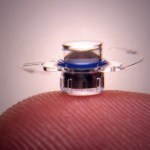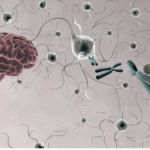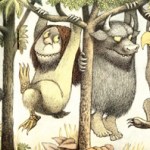biology
At my wife's suggestion, I quit work 1½ hour early today and cycled with her and the kids into the woods to pick mushrooms. Lovely sunny afternoon, and I can report that the hills between Lakes Lundsjön and Trehörningen are rich in boletes right now. Here are the species we got:
King bolete, Stensopp/Karl Johan, Boletus edulis
Velvet bolete, Sandsopp, Suillus variegatus
Orange Birch Bolete, Tegelsopp, Leccinum versepelle
Copper brittlegill, Tegelkremla, Russula decolorans
Chanterelle, Kantarell, Cantharellus cibarius
FÃ¥rticka, Albatrellus ovinus
[More about mushrooms; svamp.]
The centre piece of St. Mary's square/park in Stockholm is a brass sculpture group in a fountain, sculpted by Anders Wissler and put in place in 1903. It depicts the god Thor at the moment when he's fished the Midgard serpent up to the ocean surface and prepares to whack it in the head with his hammer. The serpent looks like a standard-issue Medieval dragon. But to either side of it are smaller lizard-like beasts that are clearly modelled after late-19th century palaeontology's ideas about dinosaurs. One is a plesiosaur. The other one, I don't know, but it's got a cylindrical snout,…
Over the years, I've written a lot about cell phones and the scientifically highly implausible claim that radio waves from cellular telephones can lead to brain cancer and other health problems. For example, two years ago, when the then director of the respected University of Pittsburgh Cancer Center, Dr. Ronald B. Herberman issued a warning to the faculty and staff of UPCC to limit their cell phone use because of the risk of cancer, I had a definite bone to pick with him. The evidence upon which Dr. Herberman based his hysterical warning, which was duly picked up by the press and spread…
If there's one aspect of medical education that I consider to be paramount, at least when it comes to understanding how to analyze and apply all the evidence, both basic science and clinical, it's a firm grounding in the scientific method. I advocate science-based medicine (SBM), which is what evidence-based medicine (EBM) should be. SBM tries to overcome the shortcomings of EBM by taking into account all the evidence, both scientific and clinical, in deciding what therapies work, what therapies don't work, and why. To recap, a major part of our thesis is that EBM, although a step forward…
I hate science press releases.
Well, not exactly. I hate science press releases that hype a study beyond its importance. I hate it even more when the investigators who published the study make statements not justified by the study and use the study as a jumping off point to speculate wildly. True, it's not always the fault of the investigators, particularly if they don't have much experience dealing with the press, but all too often scientists fall prey to the tendency to gab glibly and give the reporter what he or she wants: Pithy, juicy quotes that relate the results to what the reporter…
My grandmother suffered in her old age from macular degeneration, a common age-related eye disease that causes the center of your visual field (the macula) to gradually fritz out. As it affected her more and more, the font size in her emails ballooned to cartoonish sizes. She began walking with a cane, and needed a fancy electronic doo-dad to tell her when her cup of tea was full. By the end of her life, she was totally blind.
Watching my grandmother wink out from the world of seeing was tragic; the knowledge of macular degeneration's heredity terrifying. Relatives of those who have…
I've been fishing, swimming and walking the shoreline around my mom's summer house for almost 30 years, and so I have a pretty good idea of what kinds of fish there are out there. Most of them I have only seen during fishing with nets, so it's clear that the visible sample of fish species depends on your methods. I have never seen an eel.
Another thing I have hardly ever done around my mom's summer place is snorkeling. But during the past week, seeing as it's an unusually warm summer with unusually clear water, I've taken up that pastime. Of course, it's not anything like the coral reefs of…
Last summer I battled with wasps: this years it's ants. Small black ones have underground nests in our yard, and they usually don't bother us much. But a hot and dry summer recently inspired them to investigate our house, where they found two things they really like: sugar and water. When we returned from a trip to the archipelago, a busy ant highway stretched from the side door through a bedroom, a corridor, the dining room and into the kitchen, where the main destinations were our candy cupboard and the sink. Thousands of tiny insects.
I bought some insecticide. It looks like pale pink ice-…
My favorite part of the report above on "Chupacabras in Texas?" is when the rancher comments that the "chupacabra" he shot was "acting just like a neighbor's dog." The reason is pretty simple. It was a neighbor's dog. It got mange and lost its hair. I think the term for a Texas rancher who can't recognize a dog is "all hat and no cattle."
Reporter Grant Stinchfield has just as little right to retain his job title. He concludes the report by insisting: "No one knows for sure if the mysterious creature is the mysterious chupacabra or not." Of course we do. Chupacabras don't exist, and…
tags: The Oil Spill's Unseen Culprits, Victims, health, environment, ecology, pollution, oilspill, BP, acidification, Gulf of Mexico, dispersants, Carl Safina, TEDTalks, TED Talks, streaming video
The Gulf oil spill dwarfs comprehension, but we know this much: it's bad. Carl Safina scrapes out the facts in this blood-boiling cross-examination, arguing that the consequences will stretch far beyond the Gulf -- and many so-called solutions are making the situation worse.
TEDTalks is a daily video podcast of the best talks and performances from the TED Conference, where the world's leading…
tags: Walk-Through of NYC's American Museum of Natural History, museum, natural history museum, AMNH, American Museum of Natural History, NYC, New York City, culture, edutainment, streaming video
This is a rather nice video with a home-made feel to it. It presents a quick view of the American Museum of Natural History in New York, starting on the subway platform (filled with lots of beautiful tile art, all of which I've photographed and shared on my blog). (I noticed that they seem to have finished refurbishing their Indians of the Pacific Northwet exhibit).
The AMNH is a scientific…
I've been a critic of Arianna Huffington's massive group blog, The Huffington Post, since three weeks after it first blighted the blogosphere. That's when I first noticed that the "health" section (such as it is) of HuffPo had already become a wretched hive of scum and anti-vaccine quackery, something I began documenting again and again and again and again and again over five years ago, before Salon.com and Rolling Stone flushed their credibility right down the crapper with Robert F. Kennedy's infamous conspiracy mongering about thimerosal in vaccines. Indeed, I continue to document the…
In what was probably the worst idea since Crystal Pepsi, the corporate sponsored advertiblog has met an early and decisive end. The announcement was made this morning:
We have removed Food Frontiers from SB.
We apologize for what some of you viewed as a violation of your immense trust in ScienceBlogs. Although we (and many of you) believe strongly in the need to engage industry in pursuit of science-driven social change, this was clearly not the right way.
My hat's off to all the writer's at ScienceBlogs who put their principles ahead of their page hits. I guarantee you, however, that this…
The latest issue of the journal Science has an essay by Greg Miller looking at the explosion of research into epigenetics and what this work could suggest about human society.
In 2004, Szyf and Meaney published a paper in Nature Neuroscience that helped launch the behavioral epigenetics revolution. It remains one of the most cited papers that journal has ever published. The paper built on more than a decade of research in Meaney's lab on rodent mothering styles.
Rat moms vary naturally in their nurturing tendencies. Some lick and groom their pups extensively and arch their backs to make it…
Status report: I'm in the home stretch of writing my grant. It will be finished by 8 AM, when I have to be at work again, in tip top mental condition for the meetings I'll have to endure all morning. (What the heck happened to not doing anything substantive the day before a holiday weekend? At least I don't have to operate or see patients.) Whether it will take an all nighter to do it I am not yet sure. Whatever the case, here is the perfect mood music for late night science and grant writing.
"We're trapped in the belly of this horrible machine, and the machine is bleeding to death."
Yeah,…
tags: vultures, Gyps species, conservation biology, endangered species, veterinary medicine, toxicology, physiology, evolutionary biology, pharmaceutical chemistry, epidemiology, mathematical modeling, researchblogging.org,peer-reviewed research, journal club
Only thirty years ago, tens of millions of White-rumped Vultures, Gyps bengalensis,
were flying the skies of Asia. They are now classified as Critically Endangered.
Image: Marek Jobda / rarebirdsyearbook.com [larger view]
A zombie is another name for The Walking Dead -- those who are lifeless, apathetic, or totally lacking in…
tags: birds, ornithology, Common Raven, Northern Raven, Corvus corax, animal behavior, animal culture, aggression, dominance hierarchy, social groups, social conflict, post-conflict behavior, consolation, empathy, researchblogging.org,peer-reviewed research, journal club
Common Raven, Corvus corax, showing off at Bryce Canyon National Park, USA.
Image: United States National Park Service (Public Domain) [larger view]
Humans have long tried to distinguish themselves from other animals on the basis of characters that are perceived to be unique, such as tool design and use, planning for the…
Author's Note: The following is an excerpt from my review of Sex At Dawn: The Prehistoric Origins of Modern Sexuality. For additional information see my posts Reexamining Ardipithecus ramidus in Light of Human Origins, Those Cheating Testicles, or Who's Your Baby? as well as Helen's Lament and the Origins of Forbidden Love. Christopher Ryan also blogs at Psychology Today.
When we think of the first swinger parties most of us imagine 1970s counter-culture, we don't picture Top Gun fighter pilots in World War II. Yet, according to researchers Joan and Dwight Dixon, it was on military bases…
tags: Of Venom and Silk, arachnids, spiders, new species, endangered species, NYC, New York City, AMNH, American Museum of Natural History, streaming video
Spider biologist Norman Platnick, from the American Museum of Natural History, has traveled the world cataloguing some of these creatures, many for the first time ever. World renowned for his work, he hopes to find as many as species as possible before some disappear.
tags: Evolution in Action by AMNH, Congo River, fishes, AMNH, American Museum of Natural History, evolution, variation, biodiversity, Melanie Stiassny, streaming video
This video tells the story of speciation in Central Africa's roiling, rapid Lower Congo River. This river is home to an extraordinary assortment of fish -- many truly bizarre. This new video by Science Bulletins, the American Museum of Natural History's current-science video program, features Museum scientists on a quest to understand why so many species have evolved here. Follow Curator of Ichthyology Melanie Stiassny and her…


